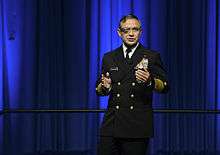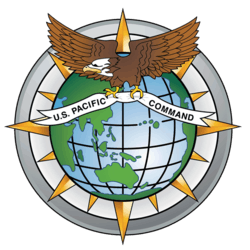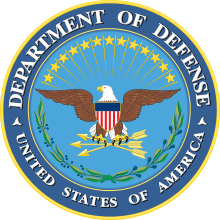Harry B. Harris Jr.
| Harry B. Harris, Jr. | |
|---|---|
 Admiral Harry B. Harris, Jr., USN Commander, United States Pacific Command | |
| Born |
August 4, 1956 Yokosuka, Kanagawa Prefecture, Japan |
| Allegiance |
|
| Service/branch | United States Navy |
| Years of service | 1978 – present |
| Rank | Admiral |
| Commands held |
United States Pacific Command United States Pacific Fleet U.S. Sixth Fleet – Naval Striking and Support Forces NATO JTF Guantanamo Patrol & Reconnaissance Wing 1 VP-46 |
| Battles/wars |
Operation Attain Document III Operation Desert Shield Operation Desert Storm Operation Earnest Will Operation Southern Watch Operation Enduring Freedom Operation Iraqi Freedom Operation Odyssey Dawn |
| Awards |
Defense Distinguished Service Medal Navy Distinguished Service Medal (3) Defense Superior Service Medal (3) Legion of Merit (3) Bronze Star (2) Air Medal Department of State Distinguished Honor Award |
Harry Binkley Harris, Jr.[1] (born August 4, 1956)[2] is an Admiral in the United States Navy who currently serves as Commander, United States Pacific Command (CDRUSPACOM). He is the first Asian-American to achieve the rank of Admiral in the U.S. Navy, the highest ranking Japanese American, and the first officer from the U.S. Navy's P-3 Orion maritime patrol aviation community to achieve 4-star rank. He was Commander, U.S. Pacific Fleet in Hawaii from 2013–2015.[3] While a Vice Admiral, he served as the Assistant to the Chairman of the Joint Chiefs of Staff.[4] Harris' prior operational command was in 2011, when he was commander of the U.S. Sixth Fleet and Naval Striking and Support Forces NATO. He is a 1978 graduate of the United States Naval Academy at Annapolis. He is also the Navy's current "Gray Owl" – the Naval Flight Officer on active duty who has held this designation the longest period. Harris took command of USPACOM on May 27, 2015.[5]
Early life
He was born in Yokosuka, Japan in 1956.[6][7] His father was a U.S. Navy chief petty officer and his mother was Japanese.[8] After his family's return to the United States, Harris grew up in Tennessee and Florida, where he attended local public schools.[9]
Military service
Harris graduated from the U.S. Naval Academy in 1978. He majored in general engineering and was a varsity fencer.
After flight training, he was designated as a Naval Flight Officer and assigned to Patrol Squadron FORTY FOUR (VP-44), homeported at Naval Air Station Brunswick, Maine. He flew the P-3C Orion, deploying throughout the Pacific, Indian and Atlantic Oceans, and Mediterranean Sea. His subsequent operational tours include assignment as a Tactical Action Officer on board USS Saratoga (CV-60), to include participation in dealing with the Achille Lauro hijacking and the 1986 air strikes against Libya (Operation Attain Document III[10]). He served as Operations Officer in Patrol Squadron FOUR (VP-4) at Naval Air Station Barbers Point, Hawaii, deploying to Southwest Asia during Operations Desert Shield/Desert Storm. He had three tours with Patrol and Reconnaissance Wing 1/Task Force 57/Task Force 72, homeported in Kami Seya, Japan. During his earlier tours with Patrol and Reconnaissance Wing 1, Harris participated in Operations Earnest Will and Southern Watch.
In 2002, he reported to Commander, U.S. Naval Forces Central Command / U.S. Fifth Fleet in Manama, Bahrain, serving as Assistant Chief of Staff for Operations, Plans, and Pol-Mil Affairs (N3/N5). He was responsible for the planning and execution of the Naval component’s portion of Operation Iraqi Freedom, which began on March 19, 2003.
His aviation command assignments include Patrol Squadron FORTY SIX (VP-46) at Naval Air Station Whidbey Island, Washington, and Patrol and Reconnaissance Wing 1/CTF 57/CTF 72 at Kami Seya, Japan. Task Force 57, the U.S. 5th Fleet maritime patrol and reconnaissance aircraft force, was heavily involved in Operation Enduring Freedom as squadrons and aircrews under his command flew nearly 1,000 P-3 and EP-3 surveillance and reconnaissance sorties over Afghanistan. Additional Flag Officer command assignments included Joint Task Force Guantanamo in Cuba, U.S. Sixth Fleet / Naval Striking and Support Forces NATO in Italy, and the U.S. Pacific Fleet.
Harris’ shore assignments include Aide and Flag Lieutenant to the Commander, U.S. Naval Forces Japan in Yokosuka, Japan; three tours on the staff of the Chief of Naval Operations to include two flag officer tours and a tour as a strategist in the Strategy and Concepts Branch; Chief Speechwriter to the Chairman of the Joint Chiefs of Staff; and Assistant to the Chairman of the Joint Chiefs of Staff. His Flag assignments are described below.

His educational assignments include selection for the Navy’s Harvard/Tufts Program, where he graduated with a Master's of Public Administration from Harvard’s John F. Kennedy School of Government in 1992. Subsequently selected as an Arthur S. Moreau Scholar, he studied international relations and ethics of war at Oxford and Georgetown University, earning a Master of Arts in National Security Studies from the latter in 1994. While at Georgetown, he was a Fellow in the School of Foreign Service. He was also an MIT Seminar 21 fellow for the 1999–2000 class.
Harris has logged 4400 flight hours, including over 400 combat hours, in U.S. and foreign maritime patrol and reconnaissance aircraft. He is a recipient of the Navy League’s Stephen Decatur Award for Operational Competence and the CIA's Agency Seal Medal. For his work in diversity and leadership, he has also received the NECO Ellis Island Honor Award, the APAICS Lifetime Achievement Award, and the WWAAC Community Spirit Award.

Director, Current Operations and Anti-Terrorism/Force Protection Division (OPNAV N31/34)
In August 2004, in his first Flag assignment, he reported to the staff of the Chief of Naval Operations, where he was responsible for Navy current operations, the Navy Command Center, and anti-terrorism/force protection policy.
Commander, Joint Task Force Guantanamo
In March 2006, he assumed command of Joint Task Force Guantanamo in Cuba. His service was notable as he was in charge when three prisoners, Mani Shaman Turki al-Habardi Al-Utaybi, Salah Ali Abdullah Ahmed al-Salami and Yasser Talal Al Zahrani, died in the custody of US forces. Defense reported the deaths as suicides. Harris said at the time,
| “ | "I believe this was not an act of desperation, but an act of asymmetrical warfare waged against us."[11] | ” |
Harris ordered a full investigation by the Naval Criminal Investigative Service (NCIS), which published its report in a heavily redacted version in August 2008.
A report, Death in Camp Delta, was published in December 2009 by the Center for Policy & Research of Seton Hall University School of Law, under the supervision of its director, Professor Mark Denbeaux, attorney for two Guantanamo detainees, criticizing numerous inconsistencies in the official accounts of these deaths.[12][13][14] The report suggested there had either been gross negligence or an attempt to cover up homicides of the men, perhaps due to torture under interrogation.
On 18 January 2010, Scott Horton of Harper’s Magazine published a story suggesting that al-Salami, Al-Utaybi and Al-Zahrani had died as a result of accidental manslaughter during a torture session, and that the official account was a cover-up.[11] Horton had undertaken a joint investigation with NBC News, based on an account by four former guards at Guantanamo Bay detention camp. They suggested that the men had died at a black site, informally called "Camp No," used for interrogation including torture. It was located about a mile outside the regular camp boundaries.[11]
Director of Operations, U.S. Southern Command
From June 2007 to April 2008, Harris served as Director of Operations (J3) for U.S. Southern Command in Miami. He led the joint planning effort for Operation Willing Spirit[15] (the rescue of American hostages held hostage in Colombia).
Deputy Chief of Naval Operations (OPNAV N6)

Harris returned to the Pentagon to serve as the Deputy Chief of Naval Operations for Communication Networks (OPNAV N6) and the Deputy Department of the Navy Chief Information Officer (Navy) until November 2009. He was responsible for early resource sponsor decisions for the Consolidated Afloat Networks and Enterprise Services (CANES), Next Generation Enterprise Network (NGEN), Mobile User Objective System (MUOS) and Maritime Domain Awareness (MDA).
Commander, U.S. Sixth Fleet
In November 2009, Harris assumed command of the U.S. 6th Fleet and the Striking and Support Forces NATO, both headquartered in Naples, Italy. He concurrently served as Deputy Commander, U.S. Naval Forces Europe and Deputy Commander, U.S. Naval Forces Africa. In 2011, he was designated as the Joint Force Maritime Component Commander (JFMCC) for Operation Odyssey Dawn, the U.S.-led coalition operation against Libya.
Assistant to the Chairman of the Joint Chiefs of Staff
In October 2011, he assumed the position of Assistant to the Chairman of the Joint Chiefs of Staff. In this capacity, he served as the Chairman's direct representative to the U.S. Secretary of State. He was also the designated U.S. Roadmap Monitor for the Middle East Peace Process.
Commander, U.S. Pacific Fleet
Harris was promoted to Admiral and assumed command of the US Pacific Fleet on October 16, 2013.[16] He has been critical of Chinese land reclamation activities in the South China Sea saying "(China is) creating a great wall of sand".[17]
Commander, U.S. Pacific Command
Harris was nominated on September 22, 2014, by President Barack Obama to command the US Pacific Command.[18][19] His appointment was confirmed by the Senate on December 11, 2014. [20][21] Harris regards North Korea as the biggest threat to security in Asia.[22] Harris took command of USPACOM on May 27, 2015.
Awards and decorations
| Naval Flight Officer insignia | |
 |
Command at Sea insignia |
 |
United States Pacific Command badge |
 |
CIA Agency Seal Medal |
References
- ↑
- ↑ https://www.congress.gov/113/chrg/shrg93919/CHRG-113shrg93919.pdf
- ↑ McAvoy, Audrey (October 16, 2013). "New commander takes over U.S. Pacific Fleet". Honolulu Star Advertiser. Retrieved October 17, 2013.
- ↑ "U.S. Navy Official Web Site". US Department of the Navy.
- ↑ Carter, Ash. "U.S. Pacific Command Change of Command". US Department of Defense. Retrieved 5 January 2016.
- ↑ Marquis Who's Who
- ↑ Steele, Jeanette (July 12, 2014). "In Pacific, 1st Asian-American fleet leader". San Diego Union-Tribune. Retrieved June 1, 2015.
- ↑ Spitzer, Kirk (May 25, 2015). "The New Head of the U.S. Pacific Command Talks to TIME About the Pivot to Asia and His Asian Roots". TIME. Retrieved June 1, 2015.
- ↑ "Official biography: Harry Harris". US Department of Defense.
- ↑ Action in the Gulf of Sidra (1986)
- 1 2 3 "The Guantánamo "Suicides": A Camp Delta sergeant blows the whistle". Harper’s Magazine. 18 January 2010.
- ↑ Seton Hall Law releases latest GTMO report, Death in Camp Delta
- ↑ Death in Camp Delta
- ↑ Mark P. Denbeaux Faculty Profile, Seton Hall University School of Law
- ↑
- ↑ McAvoy, Audrey (October 16, 2013). "New commander takes over U.S. Pacific Fleet". San Francisco Chronicle. Retrieved October 24, 2013.
- ↑ McGuirk, Rod (March 31, 2015). "US admiral says China 'creating a great wall of sand' in sea". Associated Press. Retrieved June 1, 2015.
- ↑ Kakesako, Gregg (22 September 2014). "Harris nominated to be Pacific commander". Honolulu Star-Advertiser. Retrieved 24 September 2014.
- ↑ "Flag Officer Announcement". Department of Defense News Release. 22 September 2014. Retrieved 24 September 2014.
- ↑ "Adm. Harris confirmed for Pacific Command". Rafu Shimpo. 22 December 2014. Retrieved 22 December 2014.
- ↑ "PN2085—Adm. Harry B. Harris Jr.". Congress.gov. 11 December 2014. Retrieved 11 December 2014.
- ↑ Tweed, David (9 December 2014). "China Takes Nuclear Weapons Underwater Where Prying Eyes Can't See". bloomberg.com. Retrieved 9 December 2014.
- ↑ Song, Sang-ho (3 November 2014). "U.S. Pacific Fleet chief gets Seoul's national security medal". The Korea Herald. Retrieved 12 November 2014.
External links
-
 Media related to Harry B. Harris at Wikimedia Commons
Media related to Harry B. Harris at Wikimedia Commons
